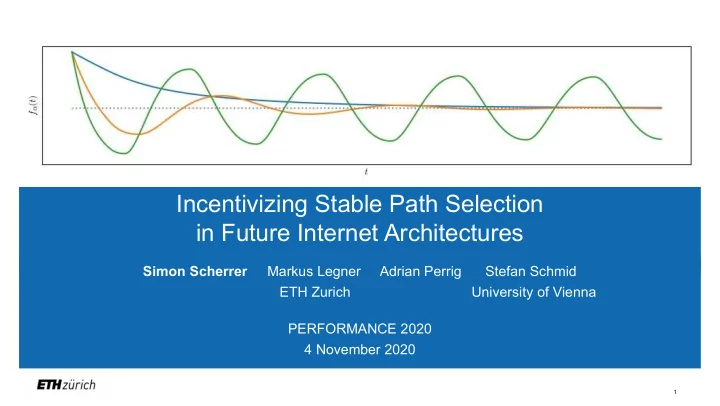

Incentivizing Stable Path Selection in Future Internet Architectures Simon Scherrer Markus Legner Adrian Perrig Stefan Schmid ETH Zurich University of Vienna PERFORMANCE 2020 4 November 2020 1
Central Question of Our Paper: Stability of Path-Aware Networks (PAN) ● Vision: Path-Aware Network (PAN) architectures allow � load-adaptive path selection by end-hosts increase resource utilization ● Concern: Load-adaptive path selection leads to oscillation if performed on the basis of outdated information. How can stable (non-oscillatory) path selection be guaranteed in future Internet architectures? 2
Why Classic Traffic Engineering Does Not Work in a PAN Internet Domain f 11 I 1 N 1 N 3 E 1 f 12 f 21 I 2 E 2 N 2 N 4 f 22 3
Why Classic Traffic Engineering Does Not Work in a PAN Internet Adaptive traffic-splitting ratios Domain f 11 I 1 N 1 N 3 E 1 f 12 f 21 I 2 E 2 N 2 N 4 f 22 4
Why Classic Traffic Engineering Does Not Work in a PAN Internet Adaptive traffic-splitting ratios Domain Domain f 11 I 1 N 1 N 3 E 1 f 12 f 21 I 2 E 2 N 2 N 4 f 22 5
Why Classic Traffic Engineering Does Not Work in a PAN Internet Domain Domain Adaptive traffic-splitting ratios Domain Domain f 11 I 1 N 1 N 3 E 1 f 12 Domain Domain Domain Domain f 21 I 2 E 2 N 2 N 4 f 22 With end-host path selection, f 11 might have to follow path I 1 -N 1 -N 3 -E 1 6
Why Classic Traffic Engineering Does Not Work in a PAN Internet Domain f 11 I 1 N 1 N 3 E 1 f 12 Path-Selection Strategy (PSS) Shift at most x traffic units per second to more attractive path Path-Selection Strategy (PSS) f 2 I 2 E 2 N 2 N 4 1 f 22 7
Why Classic Traffic Engineering Does Not Work in a PAN Internet Domain Domain Domain Domain f 11 I 1 N 1 N 3 E 1 f 12 Path-Selection Strategy (PSS) Shift at most x traffic units per second to more attractive path Domain Domain Domain Domain Path-Selection Strategy (PSS) f 2 I 2 E 2 N 2 N 4 1 f 22 In inter-domain PAN, sources are uncontrolled and self-interested � only adopt PSS that are optimal from their individual perspective 8
Inter-Domain Viability of Stable Path-Selection Strategies? ● Game-theoretic question: Will the path-selection strategies (PSS) designed for stable path selection be adopted by self-interested sources? Do these stable path-selection strategies form a Nash equilibrium? 9
Non-Oscillatory PSS ● Non-Oscillatory PSS proposed by Fischer and Vöcking (2009): ○ Path-switching probability is linear in load difference of paths ○ Linear coefficient has to respect a system-dependent upper bound to guarantee convergence ● Other PSS such as MATE (2002), Proportional Sticky Routing (2002), TeXCP (2005) etc. are structurally equivalent ○ Key idea: Reduce the migration rate between paths such that there is a strong congruence between perception and reality of the network state 10
Game-Theoretic Framework: Dynamic Routing Game Selfish sources will only adopt PSS that form PSS equilibria : ● PSS equilibrium: ○ A strategy is a PSS equilibrium strategy iff given that every end-host in the network adopts the strategy, there is no other strategy that allows an individual end-host to reduce its cost 11
Do Non-Oscillatory PSS Constitute PSS Equilibria? No! ● Universal adoption of non-oscillatory PSS makes adoption of oscillatory PSS worthwhile ● Stable path selection cannot be achieved by relying purely on end-hosts � Incentivize stable path selection with mechanisms 12
Incentive-Compatible Stabilization Mechanisms ● Idea: ○ Mechanism should alter the cost of PSS (with monitoring, punishments, requirements, etc.) such that a non-oscillatory PSS becomes a PSS equilibrium strategy ● We design two stabilization mechanisms and formally prove their incentive compatibility: ○ FLOSS mechanism (presented here) ○ CROSS mechanism (see in paper) 13
Flow-Loyalty Oscillation Suppression System (FLOSS) ● Idea: ○ Using path during a certain time interval requires a registration � (no registration packets are dropped) ○ Registrations are selectively granted: ■ Loyal end-hosts (end-hosts using the path in the current interval) always get a registration for the next interval ■ The amount of registrations available to end-hosts from other paths is limited � restrict arbitrary path migration ○ Enforce migration volume per interval to iteratively achieve equal load 14
Flow-Loyalty Oscillation Suppression System (FLOSS) 15
Flow-Loyalty Oscillation Suppression System (FLOSS) End-hosts may register for one path to use during I 0 (starting at t 0 ) 16
Flow-Loyalty Oscillation Suppression System (FLOSS) Selectively grant registrations to end-hosts on α for migration onto β 17
Flow-Loyalty Oscillation Suppression System (FLOSS) Selectively grant registrations to end-hosts on α for migration onto β 18
Flow-Loyalty Oscillation Suppression System (FLOSS) Stability at equal load � No benefit of migration for end-hosts 19
Flow-Loyalty Oscillation Suppression System (FLOSS) Mechanism enforcement can be suspended 20
Summary Our paper presents a game-theoretic framework that allows to analyze whether ● a path-selection strategy is adopted by rational end-hosts (Does it form a PSS equilibrium?) ● a stabilization mechanism is incentive-compatible Game-theoretic perspective is important to consider in path-aware Internet architectures! 21
Recommend
More recommend